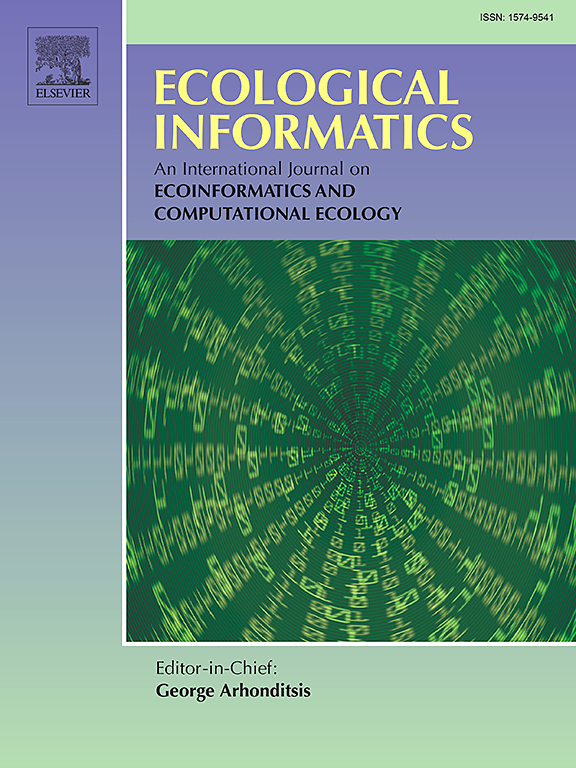改进轻量级DeepLabV3+,用于从高分辨率无人机图像中提取裸岩
IF 5.8
2区 环境科学与生态学
Q1 ECOLOGY
引用次数: 0
摘要
岩溶裸岩信息提取是地质灾害监测和生态评价的重要内容。然而,在植被稀疏的地区,裸岩表现出与周围土地覆盖相似的光谱特征,并且边界往往不清晰,这使得传统的分类方法难以准确区分这些过渡带。为了解决这些挑战,本研究提出了一种基于改进的轻量级DeepLabV3+模型的裸岩提取方法。采用MobileNetV2作为主干网,引入通道注意模块(Channel Attention Module, CAM)和空间注意模块(Spatial Attention Module, SAM)增强特征提取能力。结果表明:(1)当使用MobileNetV2作为DeepLabV3+的主干时,准确率、F1分数和MIoU分别达到97.39%、78.91%和82.11%,优于VGG16、Xception、SqueezeNet和传统分割模型。(2)将轻量级DeepLabV3+模型应用于研究区正射影像图裸岩识别,裸岩率误差约为5%,证明了该模型的实用性。(3)引入注意机制后,模型的Recall、F1得分和MIoU分别提高了14.00%、8.37%和5.62%,显著提高了识别完整性和边界准确性。同时,改进后的模型参数数为6.98 M,计算复杂度为7.24G,在保持计算效率的同时提高了精度。研究成果可为裸岩地质灾害监测预警提供准确的裸岩信息,为生态修复和风险评估提供新的技术解决方案。(数据集和代码链接:https://figshare.com/articles/dataset/Bare_rock_dataset/28143443?file=53186633)。本文章由计算机程序翻译,如有差异,请以英文原文为准。
Improved lightweight DeepLabV3+ for bare rock extraction from high-resolution UAV imagery
Bare rock information extraction in karst regions is crucial for geological hazard monitoring and ecological assessment. However, in sparsely vegetated areas, bare rock exhibits similar spectral characteristics to surrounding land cover, and the boundaries are often indistinct, making it challenging for traditional classification methods to distinguish these transitional zones accurately. To address these challenges, this study proposes a bare rock extraction method based on an improved lightweight DeepLabV3+ model. MobileNetV2 is used as the backbone network, and the Channel Attention Module (CAM) and Spatial Attention Module (SAM) are introduced to enhance feature extraction capability. Results show the following: (1) When MobileNetV2 is used as the backbone of DeepLabV3+, the Accuracy, F1 score, and MIoU reach 97.39 %, 78.91 %, and 82.11 %, respectively, outperforming VGG16, Xception, SqueezeNet, and traditional segmentation models. (2) Applying the lightweight DeepLabV3+ model to bare rock identification in orthophoto imagery of the study area results in a bare rock rate error of approximately 5 %, demonstrating the practical applicability of the model. (3) After the introduction of the attention mechanism, the model's Recall, F1 score, and MIoU increased by 14.00 %, 8.37 %, and 5.62 %, respectively, remarkably enhancing identification completeness and boundary accuracy. Meanwhile, the improved model had a parameter count of 6.98 M and a computational complexity of 7.24G, achieving enhanced accuracy while maintaining computational efficiency. The research results can provide accurate bare rock information to support geological hazard monitoring and early warning, and offer new technical solutions for ecological restoration and risk assessment. (Data sets and code links: https://figshare.com/articles/dataset/Bare_rock_dataset/28143443?file=53186633).
求助全文
通过发布文献求助,成功后即可免费获取论文全文。
去求助
来源期刊

Ecological Informatics
环境科学-生态学
CiteScore
8.30
自引率
11.80%
发文量
346
审稿时长
46 days
期刊介绍:
The journal Ecological Informatics is devoted to the publication of high quality, peer-reviewed articles on all aspects of computational ecology, data science and biogeography. The scope of the journal takes into account the data-intensive nature of ecology, the growing capacity of information technology to access, harness and leverage complex data as well as the critical need for informing sustainable management in view of global environmental and climate change.
The nature of the journal is interdisciplinary at the crossover between ecology and informatics. It focuses on novel concepts and techniques for image- and genome-based monitoring and interpretation, sensor- and multimedia-based data acquisition, internet-based data archiving and sharing, data assimilation, modelling and prediction of ecological data.
 求助内容:
求助内容: 应助结果提醒方式:
应助结果提醒方式:


